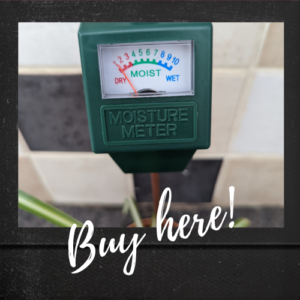![]() How often should I water my plants?
How often should I water my plants?
The age old question, with a very simple answer: as much as it needs.
Big chain garden centres and plant stores regularly overwater their stock. I get it, there are a lot of plants to look after, and not enough time to give each individual plant attention, so everything gets watered.
Unfortunately, all plants and their various species require different water, light, and humidity levels. For example, the aloe vera plant you inherited and plonked in a windowsill somewhere is probably doing pretty good.
But, of course, this isn’t the case for most plants. The good news? Making a minimal effort to pay attention to your plants makes learning when they need watering super easy.
Getting started:
-
Get to know your plant
Take a good look at your plant when you first bring it home. It is always advised to do some research on your new plant understand best how to keep it happy.
For example, if your home is kept warm, your plants will likely need watering more often as central heating dries the air. If you get beautiful direct sunlight through your window, your plant is going to dry out faster.
Checking on your plant regularly can really save you a heartache later down the road.
If your plant is drooping and has dry, browning leaves, it’s highly possible it needs a drink!
-
Pick up your pot

If it’s small enough!
When your plant is just watered, pick it up and get to know the weight of your fully saturated plant.
After a while, you’ll be able to check the weight of your plant and know that it’s time to water.
If your plant is relatively small, you could also carefully wiggle the plant and its soil out of its nursery pot and visibly check the soil for moisture. This is personally my least favourite way to check if my plant needs watering, but it works for some!
-
Check your soil
The easiest way to check if your plant needs watering, is to stick your finger in the soil and feel. Even if the top layer of soil is dry, that doesn’t always mean that your plant needs watering. Further into the soil, near the roots, it could still be damp enough to sustain your plant.
Generally, if I can feel that it’s dry up to between my first and second knuckle, I’ll give my plant a good drink.
-
Keep it humid!
A lot of houseplants found in stores are native to tropical climates. Especially in the winter months, the air in our homes gets dry and our plants just don’t get enough humidity that they need to function.
Plants constantly lose water through pores in their leaves, and the best way to reduce the amount of water lost? Humidity.

Some suggest ‘misting’ the foliage with water increases humidity – however, when those leaves have dried out this stops being the case.
It may also help to place your plant on a pebble tray filled with water; the water will evaporate into the air around the foliage.
The best way, in my opinion, is to invest in a humidifier. You can buy mini ones that fit snugly beside your plants, and I will run mine whenever my heat is on.
-
Group your plants
Not only does it look super cute, grouping your plants is a great way to remember which plants need certain requirements.
For example, I have all my ferns (and Dracaena!) placed together, out of direct light, with a small humidifier placed beside them. All these plants enjoy warmer, humid environments, under dappled/indirect light, and I find it much easier to keep track of their watering needs this way.
How much should I water my plants?
You’ve identified that your plant needs water and you’ve hit another obstacle, how much water does your plant need?
When I can see (or feel) that one of my plants needs water, I’ll water thoroughly until it runs out of the bottom of the drainage holes. I tend to leave it for ten minutes or so, and then tip away the water the soil hasn’t soaked up.
Don’t add small amounts of water that won’t soak through the soil; this will encourage a shallow root system in your plant.

What if my pot doesn’t have drainage holes?
It’s possible to keep your plant in a pot with no drainage holes, but set yourself up for success!
Letting your plant sit in water for too long is a big no-no and can lead to root rot – which is exactly as it sounds.
Helpful tools:
When I first started collecting houseplants, I took the advice of the internet and bought myself a moisture meter. They’re super cheap, and you can pick them up at garden centres or online fairly inexpensively. You can find the one that I use here.
You simply stick it in the soil and it will tell you how wet your soil is.
By using a combination of the above tips, you should be able to greatly reduce the over (and under!) watering of your plant babies, and with a little care and attention they will thrive.
I can’t wait to hear from you next time, and don’t forget to sign up to my newsletter to never miss an update.
Thank you for reading, and happy planting!
Althea





Pingback: Top 5 Low Light Indoor Plants - Sowing Wild